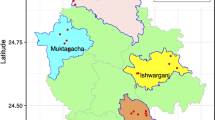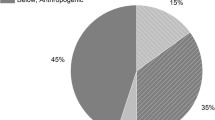Abstract
Trace elements occur in low quantities in the environment but have a crucial importance. Some elements are essential for life whereas many elements exhibit toxicity when exposure to them is too high. In this contribution, trace elements in potato are addressed. Although potato is a crop growing in the soil, the tuber does not intensively accumulate trace elements. Concentrations of trace elements are in the range of other vegetables. Generally, potato exhibits a rather low nutritional value for trace elements, with the exception of Fe, Cr, and Cu, although specific cultivars may provide significant contributions to the intake of several elements. Trace element uptake depends strongly on the plant and also on the growing environment. Soil properties that influence uptake include pH, contents of clay and organic matter, and salinity. In soils with baseline metal concentrations, concentrations of potentially toxic elements are of no concern, but Cd needs to be monitored. Environmental care and good soil management is a must to safeguard the safety of food, including potato.



Similar content being viewed by others
References
Alloway BJ (1990) Heavy metals in soils. Blackie and Son, Glasgow
Anderson KA, Magnuson BA, Tschirgi ML, Smith B (1999) Determining the geographic origin of potatoes with trace metal analysis using statistical and neural network classifiers. J Agric Food Chem 47:1568–1575. doi:10.1021/jf980677u
Anonymous (2001) Dietary reference intakes for vitamin A, vitamin K, arsenic, boron, chromium, copper, iodine, iron, manganese, molybdenum, nickel, silicon, vanadium, and zinc. National Academy Press, Washington, DC
Arnich N, Sirot V, Rivière G, et al (2012) Dietary exposure to trace elements and health risk assessment in the 2nd French Total Diet Study. Food Chem Toxicol 50:2432–2449. doi:10.1016/j.fct.2012.04.016
Arnon DI, Stout PR (1939) The essentiality of certain elements in minute quantity for plants with special reference to copper. Plant Physiol 14:371–375
Bagla P, Kaiser J (1996) India’s spreading health crisis draws global arsenic experts. Science 274:174
Becker W, Jorhem L, Sundström B, Grawé KP (2011) Contents of mineral elements in Swedish market basket diets. J Food Compos Anal 24:279–287. doi:10.1016/j.jfca.2010.10.001
Biego GH, Joyeux M, Hartemann P, Debry G (1999) Determination of dietary tin intake in an adult French citizen. Arch Environ Contam Toxicol 36:227–232
Choi M-K, Jun Y-S (2008) Analysis of boron content in frequently consumed foods in Korea. Biol Trace Elem Res 126:13–26. doi:10.1007/s12011-008-8179-7
Clemens S (2001) Molecular mechanisms of plant metal tolerance and homeostasis. Planta 212:475–486
De Temmerman L, Waegeneers N, Thiry C, et al (2014) Selenium content of Belgian cultivated soils and its uptake by field crops and vegetables. Sci Total Environ 468–469:77–82. doi:10.1016/j.scitotenv.2013.08.016
Di Giacomo F, Del Signore A, Giaccio M (2007) Determining the geographic origin of potatoes using mineral and trace element content. J Agric Food Chem 55:860–866. doi:10.1021/jf062690h
Du Laing G, Tack FMG, Verloo MG (2003) Performance of selected destruction methods for the determination of heavy metals in reed plants (Phragmites australis). Anal Chim Acta 497:191–198
Ekholm P, Reinivuo H, Mattila P, et al (2007) Changes in the mineral and trace element contents of cereals, fruits and vegetables in Finland. J Food Compos Anal 20:487–495. doi:10.1016/j.jfca.2007.02.007
European Commission (2006) Commission Regulation (EC) No 1881/2006 of 19 December 2006 setting maximum levels for certain contaminants in foodstuffs.
Florijn PJ, van Beusichem ML (1993) Uptake and distribution of cadmium in maize inbred lines. Plant Soil 150:25–32. doi:10.1007/BF00779172
Frossard E, Bucher M, Mächler F et al (2000) Potential for increasing the content and bioavailability of Fe, Zn and Ca in plants for human nutrition. J Sci Food Agric 80:861–879. doi:10.1002/(SICI)1097-0010(20000515)80:7<861::AID-JSFA601>3.0.CO;2-P
Hajšlová J, Schulzová V, Slanina P et al (2005) Quality of organically and conventionally grown potatoes: four-year study of micronutrients, metals, secondary metabolites, enzymic browning and organoleptic properties. Food Addit Contam 22:514–534. doi:10.1080/02652030500137827
Ismail F, Anjum MR, Mamon AN, Kazi TG (2011) Trace metal content of vegetables and fruits of hyderabad retail market. Pak J Nutr 10:365–372
Jinadasa KBPN, Milham PJ, Hawkins CA, et al (1997) survey of cadmium levels in vegetables and soils of Greater Sydney, Australia. J Environ Qual 26:924–933. doi:10.2134/jeq1997.00472425002600040002x
Jorhem L, Slanina P (2000) Does organic farming reduce the content of Cd and certain other trace metals in plant foods? A pilot study. J Sci Food Agric 80:43–48. doi:10.1002/(SICI)1097-0010(20000101)80:1<43::AID-JSFA482>3.0.CO;2-Y
Kabata-Pendias A (1993) Behavioural properties of trace metals in soils. Appl Geochem 8(Supplement 2):3–9. doi:10.1016/S0883-2927(09)80002-4
Kabata-Pendias A (2010) Trace elements in soils and plants. CRC, Boca Raton, FL
Kiekens L, Camerlynck R (1982) Transfer characteristics for uptake of heavy metals by plants. Landwirtsch Forsch 39:255–261
Larsen EH, Moseholm L, Nielsen MM (1992) Atmospheric deposition of trace elements around point sources and human health risk assessment. II: Uptake of arsenic and chromium by vegetables grown near a wood preservation factory. Sci Total Environ 126:263–275. doi:10.1016/0048-9697(92)90201-3
Lendinez E, Lorenzo ML, Cabrera C, López MC (2001) Chromium in basic foods of the Spanish diet: seafood, cereals, vegetables, olive oils and dairy products. Sci Total Environ 278:183–189. doi:10.1016/S0048-9697(01)00647-7
Llobet JM, Falco G, Casas C et al (2003) Concentrations of arsenic, cadmium, mercury, and lead in common foods and estimated daily intake by children, adolescents, adults, and seniors of Catalonia, Spain. J Agric Food Chem 51:838–842
López-Artíguez M, Soria ML, Cameán A, Repetto M (1993) Cadmium in the diet of the local population of Seville (Spain). Bull Environ Contam Toxicol 50:417–424
Mansour SA, Belal MH, Abou-Arab AAK, et al (2009) Evaluation of some pollutant levels in conventionally and organically farmed potato tubers and their risks to human health. Food Chem Toxicol 47:615–624. doi:10.1016/j.fct.2008.12.019
McLaughlin MJ, Palmer LT, Tiller KG et al (1994) Increased soil salinity causes elevated cadmium concentrations in field-grown potato tubers. J Environ Qual 23:1013–1018
Milacic R, Kralj B (2003) Determination of Zn, Cu, Cd, Pb, Ni and Cr in some Slovenian foodstuffs. Eur Food Res Technol Z Für Lebensm-Unters -Forsch A 217:211–214. doi:10.1007/s00217-003-0755-7
Muñoz O, Bastias JM, Araya M, et al (2005) Estimation of the dietary intake of cadmium, lead, mercury, and arsenic by the population of Santiago (Chile) using a Total Diet Study. Food Chem Toxicol 43:1647–1655. doi:10.1016/j.fct.2005.05.006
Nassar AMK, Sabally K, Kubow S et al. (2012) Some Canadian-grown potato cultivars contribute to a substantial content of essential dietary minerals. J Agric Food Chem 60:4688–4696. doi:10.1021/jf204940t
Nelson DW, Sommers LE (1982) Total carbon, organic carbon, and organic matter. In: Nelson DW, Miller RH, Keeney DR (eds) Methods of soil analysis, Part 2. Chemical and microbiological properties. ASA, Madison, Wisconsin, pp 539–579
Nielson KK, Mahoney AW, Williams LS, Rogers VC (1991) Screening for elevated lead and tin in fruits and vegetables by Nondestructive X-ray fluorescence. J Food Compos Anal 4:206–215. doi:10.1016/0889-1575(91)90032-2
Nogawa K (1981) Itai-Itai disease and follow-up studies. In: Nriagu, JO (ed) Cadmium in the Environment, Part 11, Health Effects. Wiley, New York, p 1–37
Öborn I, Jansson G, Johnsson L (1995) A field study on the influence of soil ph on trace element levels in spring wheat (Triticum aestivum), potatoes (Solanum tuberosum) and carrots (Daucus carota). Water Air Soil Pollut 85:835–840. doi:10.1007/BF00476933
Oporto C, Vandecasteele C, Smolders E (2007) Elevated cadmium concentrations in potato tubers due to irrigation with river water contaminated by Mining in Potosí, Bolivia. J Environ Qual 36:1181. doi:10.2134/jeq2006.0401
Ozturk E, Atsan E, Polat T, Kara K (2011) Variation in heavy metal concentrations of potato (Solanum tuberosum L.) cultivars. J Anim Plant Sci 21:235–239
Parker DR, Pedler JF, Ahnstrom ZAS, Resketo M (2001) Reevaluating the free-ion activity model of trace metal toxicity toward higher plants: experimental evidence with copper and zinc. Environ Toxicol Chem 20:899–906
Parveen Z, Khuhro MI, Rafiq N (2003) Market Basket Survey for Lead, Cadmium, Copper, Chromium, Nickel, and Zinc in Fruits and Vegetables. Bull Environ Contam Toxicol 71:1260–1264. doi:10.1007/s00128-003-8640-4
Queirolo F, Stegen S, Restovic M, et al (2000) Total arsenic, lead, and cadmium levels in vegetables cultivated at the Andean villages of northern Chile. Sci Total Environ 255:75–84. doi:10.1016/S0048-9697(00)00450-2
Radwan MA, Salama AK (2006) Market basket survey for some heavy metals in Egyptian fruits and vegetables. Food Chem Toxicol 44:1273–1278. doi:10.1016/j.fct.2006.02.004
Rainey CJ, Nyquist LA, Coughlin JR, Downing RG (2002) Dietary boron intake in the United States: CSFII 1994–1996. J Food Compos Anal 15:237–250
Rivero RC, Hernández PS, Rodrı́guez EMR et al (2003) Mineral concentrations in cultivars of potatoes. Food Chem 83:247–253. doi:10.1016/S0308-8146(03)00087-6
Sakamoto M, Nakano A, Akagi H (2001) Declining Minamata male birth ratio associated with increased male fetal death due to heavy methylmercury pollution. Environ Res 87:92–98
Sanchez-Castillo CP, Dewey PJS, Aguirre A, et al (1998) The mineral content of Mexican fruits and vegetables. J Food Compos Anal 11:340–356. doi:10.1006/jfca.1998.0598
Santos EE, Lauria DC, Porto da Silveira CL (2004) Assessment of daily intake of trace elements due to consumption of foodstuffs by adult inhabitants of Rio de Janeiro city. Sci Total Environ 327:69–79. doi:10.1016/j.scitotenv.2004.01.016
Simsek A, Velioglu YS, Coskun AL, Sayli BS (2003) Boron concentrations in selected foods from borate-producing regions in Turkey. J Sci Food Agric 83:586–592. doi:10.1002/jsfa.1408
Singh V, Garg AN (2006) Availability of essential trace elements in Indian cereals, vegetables and spices using INAA and the contribution of spices to daily dietary intake. Food Chem 94:81–89. doi:10.1016/j.foodchem.2004.10.053
Smies M (1983) Biological aspects of trace element speciation in the aquatic environment. In: Leppard G G (ed). Trace element speciation in surface waters and its ecological implications. Plenum, New York, p 177–191
Sobukola OP, Adeniran OM, Odedairo AA, Kajihausa OE (2010) Heavy metal levels of some fruits and leafy vegetables from selected markets in Lagos, Nigeria. Afr J Food Sci 4:389–393
Sparks DL (2001) Elucidating the fundamental chemistry of soils: past and recent achievements and future frontiers. Geoderma 100:303–319
Šrek P, Hejcman M, Kunzová E (2010) Multivariate analysis of relationship between potato (Solanum tuberosum L.) yield, amount of applied elements, their concentrations in tubers and uptake in a long-term fertilizer experiment. Field Crops Res 118:183–193. doi:10.1016/j.fcr.2010.05.009
Sungur Ş, Okur R (2009) Using azomethine-H method determination of boron contents of various foods consumed in Hatay Region in Turkey. Food Chem 115:711–714. doi:10.1016/j.foodchem.2008.11.103
Tack FMG (2010) Trace elements: general soil chemistry, principles and processes. In: Hooda P (ed) Trace elements in soils. Wiley-Blackwell, Chichester, pp 9–37
Tahvonen R (1993) Contents of selected elements in some fruits, berries, and vegetables on the Finnish market in 1987–1989. J Food Compos Anal 6:75–86. doi:10.1006/jfca.1993.1009
Tondel M, Rahman M, Magnuson A et al (1999) The relationship of arsenic levels in drinking water and the prevalence rate of skin lesions in Bangladesh. Environ Health Perspect 107:727
Tsongas TA, Meglen RR, Walravens PA, Chappell WR (1980) Molybdenum in the diet: an estimate of average daily intake in the United States. Am J Clin Nutr 33:1103–1107
Van Dokkum W (1995) The intake of selected minerals and trace elements in European countries. Nutr Res Rev 8:271–302. doi:10.1079/NRR19950016
Van Dokkum WV, De Vos RH, Muys T, Wesstra JA (1989) Minerals and trace elements in total diets in The Netherlands. Br J Nutr 61:7–15. doi:10.1079/BJN19890087
Van Ranst E, Verloo M, Demeyer A, Pauwels JM (1999) Manual for the soil chemistry and fertility laboratory. International Training Centre for Post-Graduate Soil Scientists, Gent, Belgium
White PJ, Broadley MR (2005) Biofortifying crops with essential mineral elements. Trends Plant Sci 10:586–593. doi:10.1016/j.tplants.2005.10.001
White PJ, Bradshaw JE, Finlay M et al (2009) Relationships Between Yield and Mineral Concentrations in Potato Tubers. HortSci 44:6–11
Ysart G, Miller P, Croasdale M et al (2000) 1997 UK Total Diet Study dietary exposures to aluminium, arsenic, cadmium, chromium, copper, lead, mercury, nickel, selenium, tin and zinc. Food Addit Contam 17:775–786. doi:10.1080/026520300415327
Zhao F-J, McGrath SP (2009) Biofortification and phytoremediation. Curr Opin Plant Biol 12:373–380
Acknowledgements
The author acknowledges Arne Demey for his involvement in the survey.
Author information
Authors and Affiliations
Corresponding author
Rights and permissions
About this article
Cite this article
Tack, F.M.G. Trace Elements in Potato. Potato Res. 57, 311–325 (2014). https://doi.org/10.1007/s11540-014-9268-y
Received:
Published:
Issue Date:
DOI: https://doi.org/10.1007/s11540-014-9268-y




